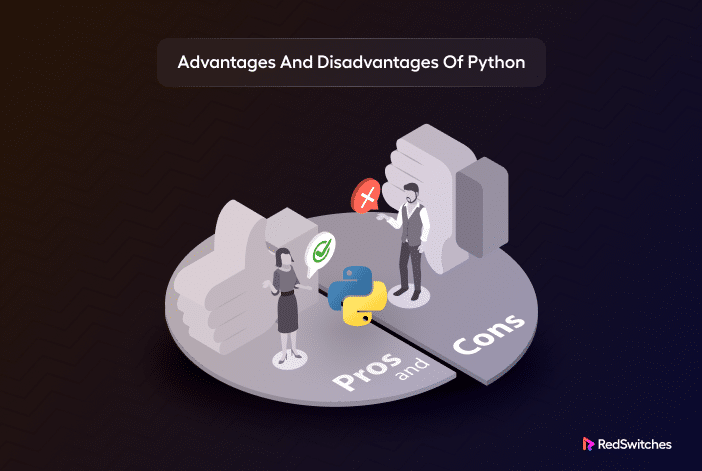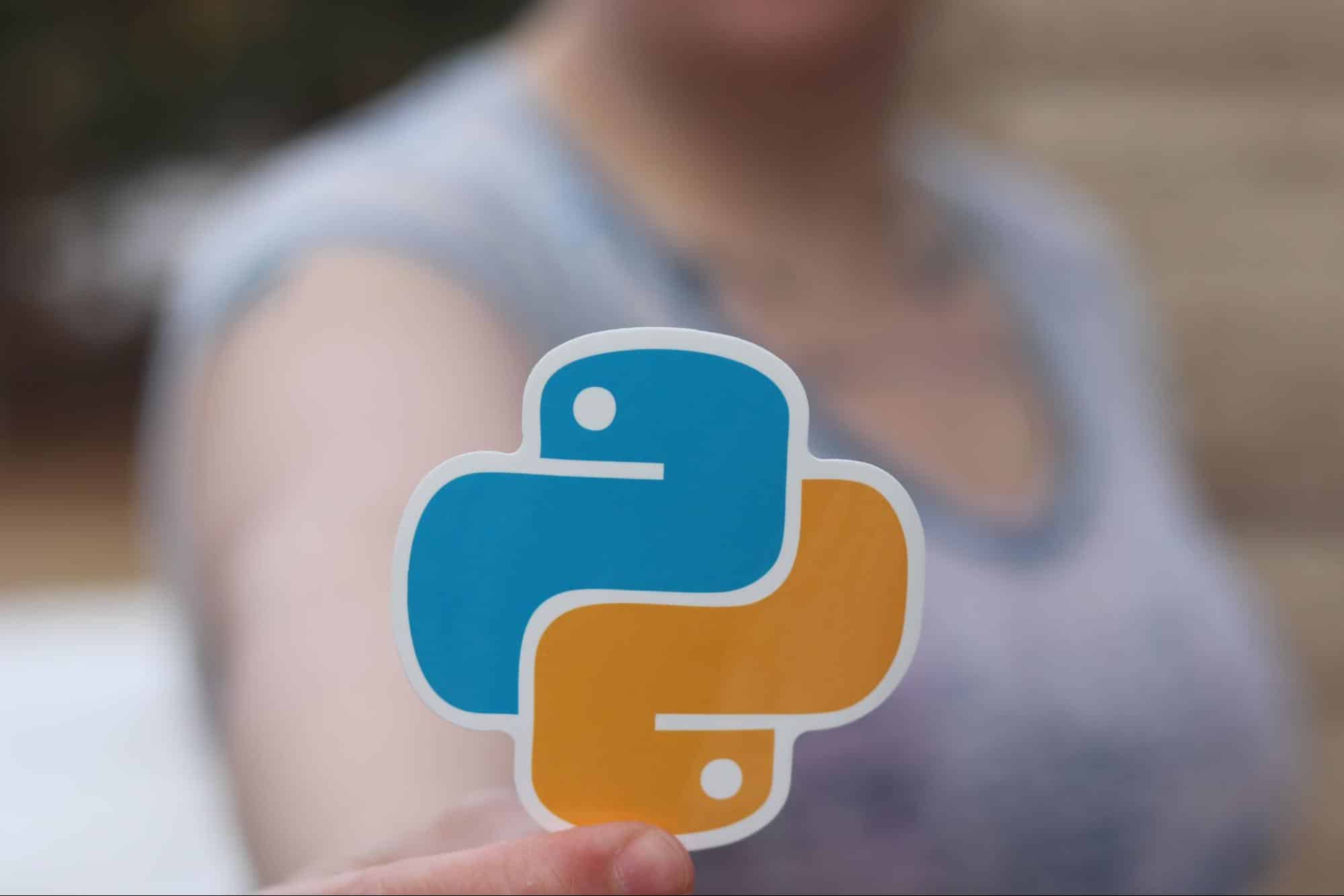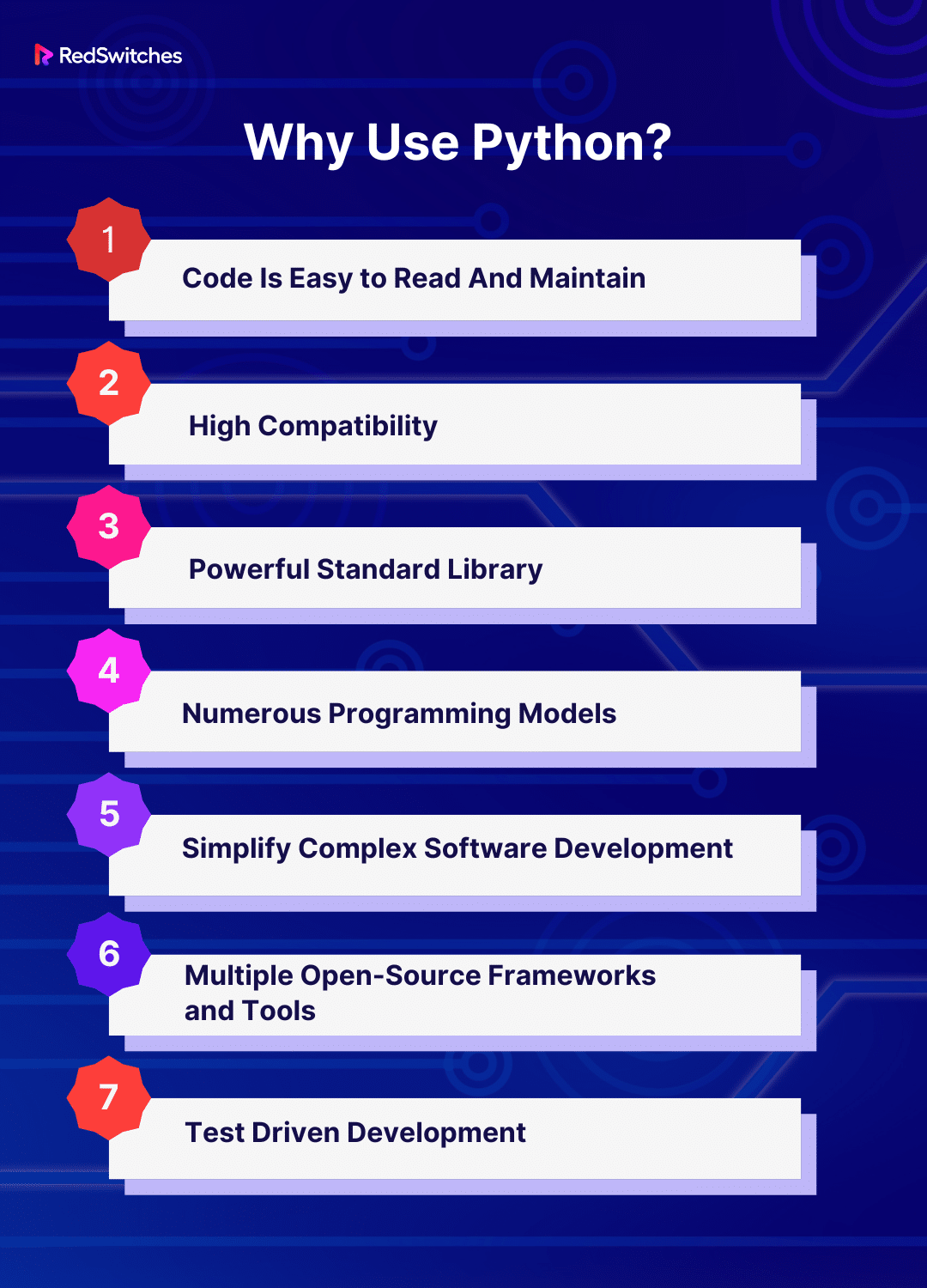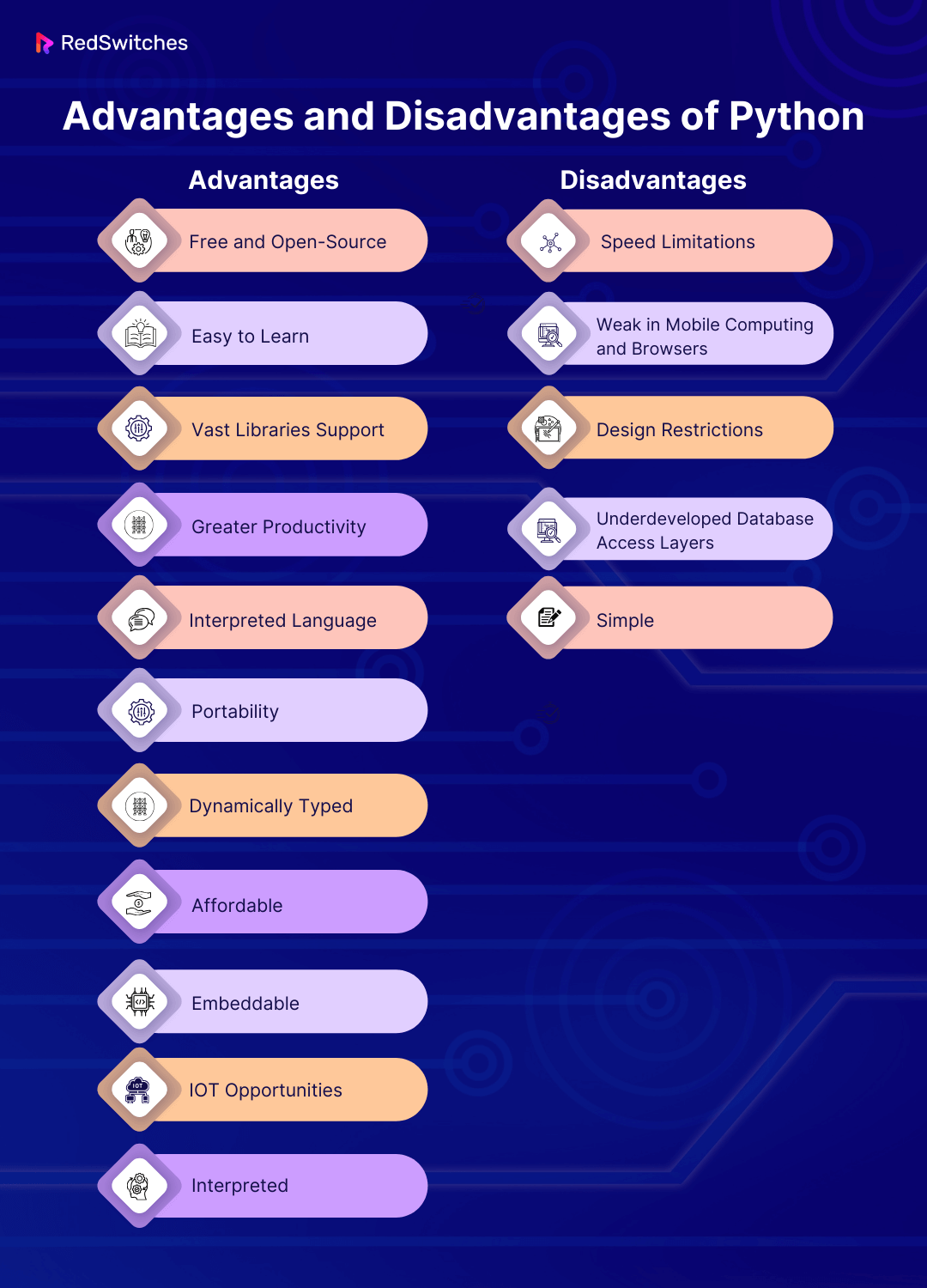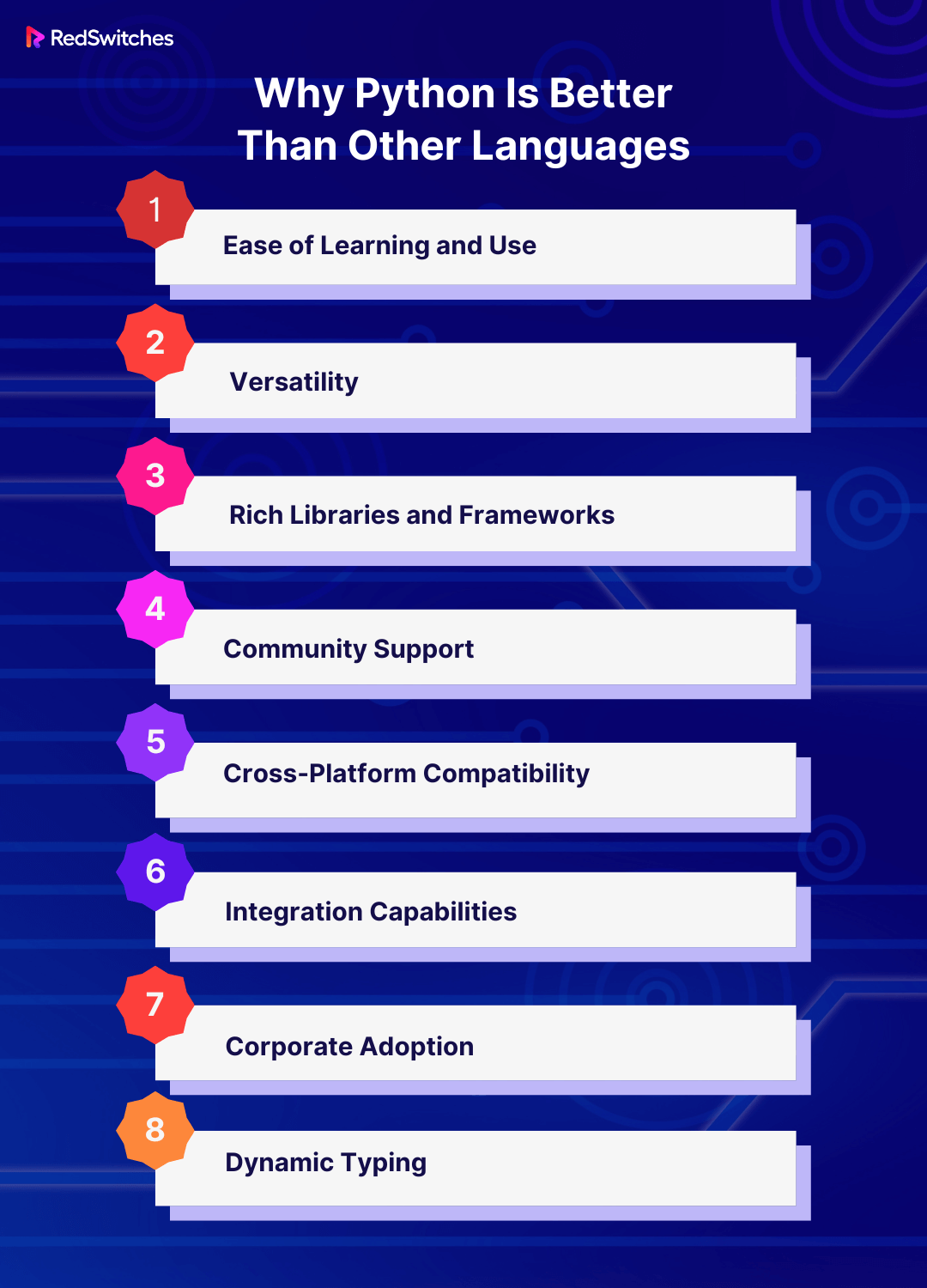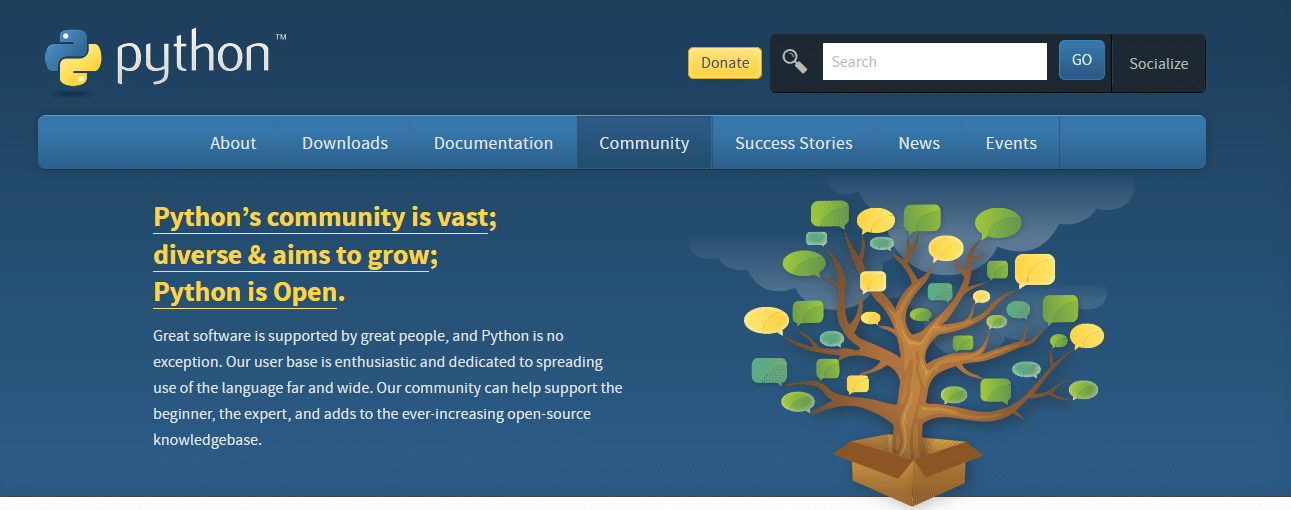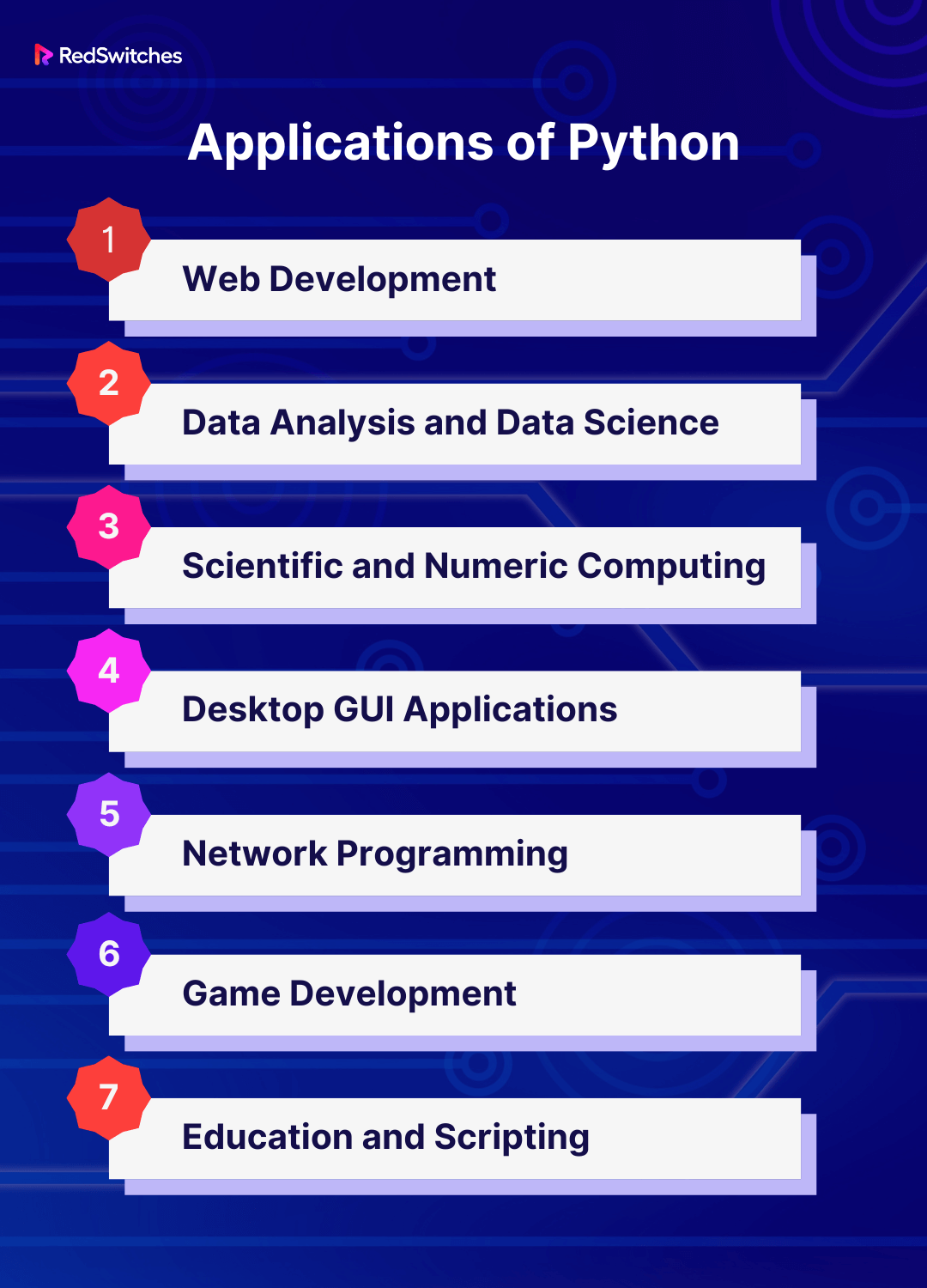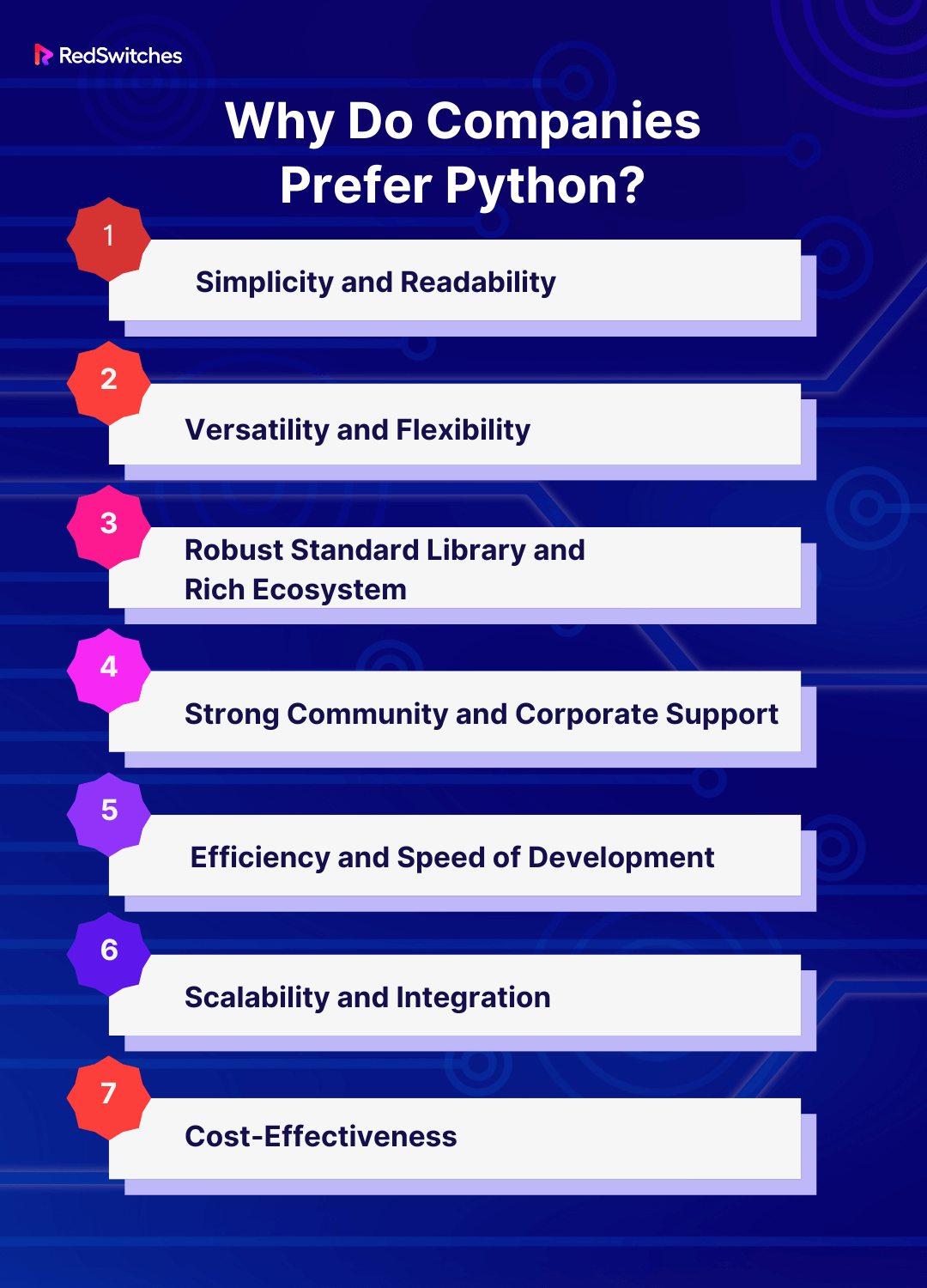Did you know that, as of 2023, Python has been labeled the most widely used programming language among developers worldwide, according to Statista? The programming language stands out as a frontrunner, renowned for its simplicity, versatility, and wide-ranging applications.
Although it is prevalent in the programming language realm, it is important to understand that it may not be suitable for everyone. While Python may offer advantages for some developers, it may also have several drawbacks. This makes it important for all developers to understand the advantages and disadvantages of Python.
This blog aims to provide a comprehensive overview of the advantages and disadvantages of Python. By the end of this exploration, you’ll have a clearer understanding of the advantages and disadvantages of Python, helping you determine whether the benefits outweigh the cons for you or vice versa.
Table of Contents
- What is Python?
- Why Use Python?
- Python Programming Language Advantages and Disadvantages
- Why Python Is Better Than Other Languages
- Applications of Python
- Why Do Companies Prefer Python?
- Conclusion – Advantages and Disadvantages of Python
- FAQs
What is Python?
Credits: Pexels
Before we examine the advantages and disadvantages of the Python programming language, it is important to understand its definition.
Python is a renowned programming language recognized for its simplicity and readability. It was created by Guido van Rossum and first released in 1991. Python emphasizes code readability with its notable use of significant whitespace. It supports multiple programming paradigms, including object-oriented, procedural, and functional programming.
Python’s comprehensive standard library, with its robust frameworks and vast community support, makes it highly versatile and suitable for various applications, from web and software development to scientific and mathematical computing. Its syntax is designed to be intuitive, and its code is more readable, which makes it an excellent choice for beginners in programming.
Thanks to its powerful and user-friendly data analysis libraries, Python has also been integral in the rise of data science and machine learning. With its increasing popularity and wide-ranging applications, Python has become one of the most sought-after programming languages in the world.
Why Use Python?
Before diving into the advantages and disadvantages of Python, let’s discuss why one should use Python:
1. Code Is Easy to Read And Maintain
Credits: Pexels
One of Python’s most significant advantages is its readability. Its syntax is clean and expressive, closely resembling the English language. This readability makes Python an excellent language for beginners and simplifies maintenance and updates for experienced programmers.
Code readability is crucial in a collaborative environment, making it easier for others to understand and work on the same project. This ease of reading and maintenance reduces the risk of errors and misunderstandings, streamlining the development process.
2. High Compatibility
Python’s most significant advantage is its high compatibility across different platforms. Whether it’s MacOS, Linux, Windows, or even obscure operating systems, Python ensures seamless operation. This universality means that Python scripts written on one platform can be easily transferred and executed on another without any modifications, a feature known as ‘write once, run anywhere.’
This compatibility extends to working with various programming languages as well. Python can integrate with C and C++, allowing for performance optimizations and legacy code use. This interoperability makes Python an excellent choice for projects that must bridge different technologies and platforms, facilitating a more collaborative and flexible development environment.
3. Powerful Standard Library
Python’s standard library includes countless tools and modules, enabling programmers to perform various tasks without writing additional code. Python’s standard library is comprehensive and versatile, from handling internet protocols, support for web services, and interfacing with operating system functions to complex data manipulation and graphical user interfaces.
This extensive library boosts productivity and ensures that Python can be applied to various programming tasks and challenges, making it an incredibly resourceful tool in a developer’s toolkit.
4. Numerous Programming Models
Python’s adaptability extends to its support for various programming models. It’s an object-oriented language that promotes code reusability and simplifies complex software design. Python also supports other programming paradigms, including procedural and functional programming.
This flexibility allows developers to choose the most suitable approach for their project, enhancing Python’s utility across different types of applications. Whether it’s a simple script, a complex application, or a data analysis task, Python’s multi-paradigm nature makes it a versatile choice for many programming needs.
5. Simplify Complex Software Development
Python’s strength lies in simplifying complex software development processes. Its straightforward syntax, closely resembling English, makes it accessible to developers of all skill levels. This clarity speeds up development and makes maintenance and updates more manageable.
In addition to its user-friendly syntax, Python’s extensive standard library and a plethora of third-party modules and packages allow developers to perform a wide range of tasks without the need to write code from scratch. From web development to data analysis, Python’s libraries and frameworks provide robust solutions that reduce the complexity and time required to develop sophisticated software.
6. Multiple Open-Source Frameworks and Tools
Another reason developers gravitate toward Python is its rich selection of open-source frameworks and tools. Frameworks like Django and Flask for web development, Pandas and NumPy for data analysis, and TensorFlow and PyTorch for machine learning are just a few examples of the resources available to Python developers.
These frameworks expedite the development process and ensure that applications are secure, scalable, and maintainable. Their open-source nature means they are constantly being improved by a global community of developers, ensuring that the latest trends and best practices are always incorporated..
7. Test Driven Development
Another area where Python excels is in facilitating Test-Driven Development (TDD). TDD is a software development approach where tests are written before the code. Python’s standard library includes a built-in module called unit test, which supports the creation of tests quickly and efficiently.
This approach ensures the code is reliable and reduces the likelihood of bugs, making it especially valuable in large and complex projects. The simplicity of writing tests in Python encourages developers to adopt TDD, which leads to higher-quality software that is easier to maintain and update.
Now that we have discussed why one must use Python, let’s explore the advantages and disadvantages of Python.
Read our Python blog to learn more about Python.
Also Read: How to Install Rust on Ubuntu 20.04/22.04
Python Programming Language Advantages and Disadvantages
Credits: FreePik
Understanding the advantages and disadvantages of Python can offer valuable information on whether it is a suitable programming language for your specific needs and requirements. Below is a list of the top advantages and disadvantages of Python:
Advantages of Python
1. Free and Open-Source:
When discussing the advantages and disadvantages of Python, one advantage stands out the most: the programming language’s status as a free and open-source language. This aspect not only makes it accessible to everyone, from individual hobbyists to large corporations but also fosters a strong sense of community. Being open-source means that Python is continuously refined and improved by its vibrant community of contributors.
This collaborative environment ensures that the language stays up-to-date with the latest trends and needs of developers. The open-source nature allows programmers to modify the language to fit their specific requirements, enhancing its adaptability and making it a dynamic tool in the programmer’s toolkit.
2. Easy to Learn
When debating the advantages and disadvantages of Python, the programming language syntax stands out as a considerable benefit. Python is celebrated for its clarity and readability, making it an excellent choice for beginners. It resembles the English language, significantly reducing the learning curve and allowing newcomers to grasp the programming fundamentals without being overwhelmed by complex syntax rules.
This simplicity benefits beginners and experienced developers, who can focus on solving problems rather than deciphering code. The straightforward syntax promotes clean and maintainable code, a crucial factor in larger projects where readability and simplicity are key to efficient collaboration and debugging.
3. Vast Libraries Support
The extensive libraries available in Python are a testament to its versatility. These libraries cover various programming needs, from web development with frameworks like Django and Flask to scientific computing with tools like NumPy and SciPy.
For those delving into data science and machine learning, Pandas, TensorFlow, and Scikit-learn libraries offer powerful, sophisticated, and accessible functionalities. This rich library ecosystem saves developers time and effort and opens doors to new possibilities in various domains, making Python a truly multifaceted language.
4. Greater Productivity
When exploring the advantages and disadvantages of Python, one of the standout benefits of Python is its potential to boost productivity. The language’s design philosophy, which emphasizes code readability and simplicity, enables developers to write fewer lines of code for the same task than languages like Java or C++. This conciseness speeds up the development process, makes the code more maintainable, and reduces the chance of errors.
Python’s extensive standard library and a vast array of third-party modules allow developers to easily add functionality without writing it from scratch. This, coupled with Python’s support for multiple programming paradigms, including object-oriented, procedural, and functional programming, empowers developers to approach problems most effectively.
5. Interpreted Language
Python is an interpreted language, meaning code is executed line by line. This feature brings several advantages, especially in terms of debugging and testing. Since the interpreter processes the code at runtime, any errors in the code are reported as soon as they occur, often with a detailed traceback.
This immediate feedback loop is invaluable for quick debugging and iterative development. Being interpreted allows Python to be highly interactive; you can test your code snippets in real-time using tools like Python’s interactive shell or Jupyter Notebooks, which is particularly beneficial for data analysis and scientific computing.
6. Portability
Python’s design philosophy emphasizes cross-platform compatibility and portability. Python programs can run on various operating systems without requiring modifications to the code. This universality results from Python’s implementation in C, which is a portable language in itself. Whether you’re working on macOS, Windows, Linux, or Unix, Python ensures a smooth experience.
This portability makes it much easier for teams to collaborate on projects without worrying about each member’s operating system. It also simplifies the deployment process, as the same Python application can be deployed across different environments, making it a highly flexible choice for developers.
7. Dynamically Typed
Python’s dynamic typing shines bright in the debate on the advantages and disadvantages of Python. Unlike statically typed languages, where you have to declare the type of each variable, Python infers the variable type at runtime. This feature enhances the flexibility of the language, allowing for faster development and less verbose code.
Dynamic typing allows a single function to process different data types, fostering a more fluid programming style and reducing boilerplate code. This flexibility can sometimes lead to unexpected bugs, which are only caught at runtime.
8. Affordable
Another key advantage of Python is its affordability. Being an open-source language, Python is completely free to use and distribute, even for commercial purposes. This makes it an accessible choice for startups and individual developers who might not have the budget for expensive licensing fees.
The wide range of free libraries and frameworks available in Python reduces development costs further. Whether web development, data analysis, artificial intelligence, or scientific computing, Python provides a cost-effective solution with many applications.
Credits: FreePik
9. Embeddable
Python’s embeddable feature is often overlooked but is incredibly powerful. It can be embedded within other languages, like C or C++, to provide scripting capabilities for large applications. This means developers can write performance-critical parts of their application in languages like C++ and use Python for higher-level logic and scripting.
This blend offers the best of both worlds: the speed and efficiency of compiled languages and the simplicity and flexibility of Python. It opens avenues for integrating Python into various systems, enhancing existing applications without a complete overhaul.
10. IOT Opportunities
Python is increasingly popular in the Internet of Things (IoT) domain due to its simplicity and flexibility. It enables developers to prototype and deploy IoT applications quickly. Its vast library ecosystem, including tools like Raspberry Pi and Arduino, simplifies the development of IoT devices.
Python’s ability to handle data manipulation and its compatibility with microcontrollers and sensors make it an ideal choice for IoT projects, which often require processing and analyzing large volumes of data from various sources. Its platform independence ensures that Python-based IoT applications can be easily ported across different devices and systems, enhancing the scalability of IoT solutions.
11. Interpreted
As an interpreted language, Python offers several advantages. It facilitates rapid development and testing, as code can be executed as soon as it is written without requiring a separate compilation step. This feature significantly speeds up the development process and makes Python an excellent choice for prototyping and iterative development.
Python’s interpreted nature makes it more flexible and dynamic, allowing for easier debugging and immediate feedback during the coding process. It also contributes to Python’s cross-platform compatibility, as the same Python code can run on multiple operating systems without modification, making it highly versatile for various applications.
Also Read 15 Best PHP Frameworks for Web Development in 2024: A Guide For Newbies & Experts.
Disadvantages of Python
1. Speed Limitations
When discussing the advantages and disadvantages of Python, the programming language’s speed limitation stands out as one of its most significant drawbacks. Python is an interpreted language, which means the code is executed line-by-line. While this approach benefits debugging, it performs slower than compiled languages like C or Java.
This can be a notable hindrance for applications where speed is critical, such as high-frequency trading algorithms or intensive scientific computations. Python’s dynamic nature, which adds to its ease of use, also contributes to its slower performance because the data type of a variable can change at runtime, requiring more time for processing.
2. Weak in Mobile Computing and Browsers
Python’s presence in mobile computing and web browsers is relatively weak compared to other languages. While there are frameworks like Kivy for mobile app development in Python, Java for Android, or Swift for iOS, they are more powerful and popular. This limitation significantly reduces Python’s viability for mobile app development.
Similarly, Python is not natively used in web browsers. Although technologies like Brython allow Python code to run in browsers, they are not widely adopted. This situation forces developers to rely on more traditional web technologies like JavaScript for client-side scripting.
3. Design Restrictions
Python’s design imposes some restrictions that can be challenging for developers. One notable issue is Python’s use of the Global Interpreter Lock (GIL) in its primary implementation, CPython. The GIL allows only one thread to execute at a time, limiting Python’s ability to perform efficient parallel processing, a critical aspect in today’s multi-core processor era.
This makes Python less suitable for applications requiring intensive concurrent processing. While user-friendly, Python’s dynamic typing can lead to runtime errors only caught during execution, potentially increasing the risk of bugs in large codebases.
4. Underdeveloped Database Access Layers
Python’s database access layers are another area where it falls short. Python’s options can seem somewhat underdeveloped compared to other languages with robust, mature, and optimized frameworks for database interaction. This is particularly evident when dealing with large-scale, complex database operations.
The available tools and libraries in Python for database access often require additional effort to achieve the level of efficiency and performance seen in other languages. For businesses relying heavily on extensive database interactions, this can lead to increased development time and potential performance issues.
5. Simple
When considering the advantages and disadvantages of Python, it is important to understand that while a feature may be an advantage for someone, it may be a disadvantage for another.
For example, Python is renowned for its simplicity and readability, which is a significant reason behind its popularity, especially among beginners. This simplicity can sometimes be a disadvantage, particularly in large-scale, complex projects.
Python’s straightforward syntax and dynamic nature can lead to hidden bugs, especially in large codebases where strict type-checking is beneficial. Python’s simplicity might lead to overlooking good programming practices, resulting in less efficient code and harder maintenance.
Comparison Table: Advantages and Disadvantages of Python
Below is a comparison table of the advantages and disadvantages of Python:
Also Read: Update Python To Version 3.9 On Windows, MacOS, And Linux.
Although the advantages and disadvantages of Python discussed above offer valuable insight into why Python is better than other languages, let’s further shed light on this topic by discussing why Python is better.
Why Python Is Better Than Other Languages
What makes Python stand out among programming languages? Let’s explore the reasons why Python is often considered superior to others.
Ease of Learning and Use
Python’s syntax is clean and straightforward, making it incredibly easy to learn, especially for beginners. Python’s syntax is less cluttered and more readable. It also bears a striking resemblance to English. This readability makes Python an excellent choice for beginners and allows experienced programmers to focus on solving problems rather than deciphering code.
Versatility
Python is a versatile language used in web development, data science, artificial intelligence, machine learning, automation, and more. Its versatility makes it a one-stop language for various applications, reducing the need to learn multiple languages for different tasks.
Rich Libraries and Frameworks
Python has an extensive standard library and a vast ecosystem of third-party packages and frameworks. Libraries like NumPy, Pandas, and TensorFlow have become staples in data science and machine learning, while frameworks like Django and Flask are popular choices for web development. This rich set of resources reduces the code needed and speeds up development.
Community Support
Credits: Python Website
Python has one of the largest and most enthusiastic communities among programming languages. This community contributes to documentation, forums, tutorials, and conferences. You can easily find information on the programming language or community support for any issue or question, which is invaluable for developers at all levels.
Cross-Platform Compatibility
Python is inherently cross-platform. It can be run on Windows, macOS, Linux, and even more exotic operating systems. This feature is handy for developers who work in diverse computing environments or who need to deploy applications across different platforms.
Integration Capabilities
Python is a good partner. It can be easily integrated with other programming languages like C, C++, and Java. This interoperability is particularly useful in projects requiring performance optimizations or legacy systems written in these languages.
Corporate Adoption
Big players like Google, Netflix, and Instagram have adopted Python for their operations. Python’s scalability and efficiency make it suitable for startups and large enterprises. The language’s widespread industry adoption also means better job prospects for Python developers.
Dynamic Typing
Although we have listed dynamic typing as a disadvantage in the list of the advantages and disadvantages of Python mentioned above, it is worth noting that it can also be an advantage.
While dynamic typing can lead to more runtime errors, it can be more flexible than static typing languages. Dynamic typing allows for faster development and less boilerplate code.
Are you wondering how to check the Python Version in Linux, macOS, and Windows? Read our informative blog, ‘How to Check Python Version in Linux, Windows, And macOS: A Comprehensive Guide.’
Applications of Python
Below are a few fields where Python serves as an applicable programming language:
Web Development
Building Web Frameworks
Python’s role in web development is highly prominent, thanks to its powerful frameworks like Django and Flask. Django is a comprehensive framework providing almost everything a developer needs to build complex, data-driven web applications. It includes an ORM (Object-Relational Mapping) for database interactions, a templating engine, routing, authentication, and numerous other features.
Flask offers a more minimalistic and flexible approach. It is particularly favored for creating microservices and small to medium-sized web applications due to its simplicity and lightweight nature. Flask allows developers to choose their tools and extensions, making it a highly customizable option for web development.
API Development
Python shines through its frameworks like FastAPI in the realm of backend development. FastAPI, a modern, fast (high-performance) web framework, is designed to build APIs with Python 3.7+ based on standard Python-type hints. Its simplicity and fast performance make it an excellent choice for developing RESTful APIs, a cornerstone in the communication between different software applications.
Data Analysis and Data Science
Data Manipulation
The revolution in data manipulation can be primarily attributed to Python’s libraries, Pandas and NumPy. Pandas offer data structures and operations for manipulating numerical tables and time series, making them perfect for data munging and preparation. NumPy adds support for large, multi-dimensional arrays and matrices, along with a collection of high-level mathematical functions to operate on these arrays.
Statistical Analysis and Modeling
Python’s SciPy library, an open-source software ecosystem for mathematics, science, and engineering, is pivotal in statistical analysis. It provides modules for optimization, integration, interpolation, eigenvalue problems, algebraic equations, and other purposes, making it an indispensable tool in scientific computing.
Machine Learning and AI
Python libraries, including TensorFlow and Scikit-learn, are at the forefront of machine learning and artificial intelligence. TensorFlow, developed by the Google Brain team, is an open-source library for numerical computation and machine learning. Scikit-learn, meanwhile, is used for data mining and data analysis, providing simple and efficient tools for predictive data analysis.
Scientific and Numeric Computing
Astronomy and Astrophysics
Python aids significantly in the fields of astronomy and astrophysics. Astropy, a library specifically designed for astronomy, offers functionalities like celestial coordinates, time and date handling, and file reading for common file formats in astronomy. This has made Python a go-to language for astronomers for data analysis and simulation.
Bioinformatics
In the world of bioinformatics, Python plays a critical role. Biopython, for instance, is a set of freely available tools for biological computation. It assists in tasks like DNA sequencing, running molecular dynamics simulations, and analyzing genomic data, contributing to medical science and research advancements.
Desktop GUI Applications
Application Development
For desktop GUI application development, Python offers several choices. Tkinter, the standard GUI toolkit for Python, is widely used for its simplicity and effectiveness. PyQt and Kivy are also popular choices for more complex or cross-platform applications. PyQt brings together the Qt C++ cross-platform application framework with Python, while Kivy is an open-source Python library for developing multitouch applications.
Network Programming
Server and Network Automation
Python’s scripting capabilities make it a highly efficient tool for network automation. It is used to configure routers and switches, manage network changes, and monitor network performance. Python scripts can automate various network administration tasks, significantly reducing the time and effort required for network management.
Socket Programming
Python is also widely used in socket programming – essential for handling network communications. This capability is crucial for developing applications like chat applications, email clients, and FTP (File Transfer Protocol) clients.
Game Development
Credits: FreePik
Building Games
While Python may not be the primary choice for high-end game development, it is an excellent platform for creating educational and simple 2D games. Libraries like Pygame provide the necessary tools for developing such games, offering sound, graphics, and network functionality modules.
Education and Scripting
Learning Programming
Python’s straightforward syntax and readability make it an ideal first language for beginners. Its widespread use in educational settings is a testament to its suitability for teaching fundamental programming concepts.
Automation Scripts
One of Python’s most significant strengths is its ability to write scripts for automating repetitive tasks. These scripts can manage file systems, automate system administration tasks, and efficiently handle large amounts of data.
Also Read: Install Python Pip On Ubuntu In 3 Simple Steps.
Why Do Companies Prefer Python?
Although the abovementioned advantages and disadvantages of Python offer great insight into why companies prefer it, let’s further discuss the matter below.
Simplicity and Readability
At the heart of Python’s appeal is its simplicity and readability. Python’s syntax is clear and concise, making it easy to learn and use. This accessibility allows companies to save time and resources in training developers. Moreover, Python’s readability ensures that code is easy to understand and maintain, reducing the likelihood of errors and simplifying the process of updating and upgrading software.
Versatility and Flexibility
Python’s versatility is another significant factor in its corporate popularity. It is a multi-paradigm language that supports object-oriented, procedural, and functional programming styles. This flexibility allows it to be used for various applications, from web development with frameworks like Django and Flask to data analysis with libraries like Pandas and NumPy.
Robust Standard Library and Rich Ecosystem
Python’s extensive standard library provides many modules and tools ready to use. This reduces the need to write additional code for basic tasks. Furthermore, the Python ecosystem is rich with third-party libraries and frameworks, expanding its capabilities even further.
Strong Community and Corporate Support
Python benefits from a robust and active community and corporate support. An active community means a wealth of shared knowledge, regular updates, and a large pool of experienced developers. Corporate support from tech giants like Google and Facebook contributes to the development and maintenance of Python, ensuring its relevance and longevity.
Efficiency and Speed of Development
Python’s design philosophy emphasizes code readability and efficiency, allowing developers to write fewer lines of code to accomplish tasks than other languages like Java or C++. This efficiency translates into faster development times, enabling companies to accelerate their product development cycles and bring products and services to market more quickly.
Scalability and Integration
Python scales well, making it suitable for both small-scale applications and large, complex systems. Its ability to integrate with other languages and technologies is a significant advantage. Python can easily work with C/C++ libraries and can be integrated into .NET components.
Cost-Effectiveness
Credits: FreePik
Python is an open-source language, which makes it a cost-effective option for companies. There are no licensing fees, and the wide availability of free libraries and tools further reduces development costs. This can be crucial in choosing a programming language for startups and small businesses.
Conclusion – Advantages and Disadvantages of Python
Like every other programming language, Python has pros and cons. While it is known for its readability, versatility, and thriving library ecosystem, it also has limitations, such as performance limitations, the Global Interpreter Lock (GIL), and occasionally slower execution speed than C or C++. Understanding the advantages and disadvantages of Python can offer valuable insight into whether it suits you.
If you’re considering Python for your next project, you’ll need a reliable hosting service to ensure your applications run smoothly and efficiently. RedSwitches, a leader in the hosting industry, offers top-notch Python hosting solutions.
With our state-of-the-art infrastructure and exceptional support, you can confidently deploy your Python applications and harness the power of this versatile language without worrying about server-related hassles. Visit RedSwitches today to learn more about how we can support your Python endeavors and Dedicated Server.
FAQs
The three benefits of Python are that it is free and open-source, easy to learn, and includes extensive libraries. These benefits are what make Python a prevalent programming language.
Q. What are the advantages and disadvantages of working in script mode in Python?
When talking about Python advantages and disadvantages, in terms of working in script mode, it is important to discuss writing and saving codes in files and the lack of immediate feedback. The key advantage of working in script mode in Python is writing and saving code in files. This mode facilitates the development of more extensive, more structured programs than the interactive mode. The disadvantage lies in the lack of immediate feedback in an interactive mode.
Q. What is the best advantage of Python?
The best advantage of Python is that it is open-source. This means that beginners and startups can use it for free without worrying about incurring costs.
Q. What are the advantages of Python programming language?
Python has a simple and easy-to-understand syntax, making it a great language for beginners. It is widely used for web development, data analysis, and artificial intelligence, and has a large and active community for support and resources.
Q. What are the disadvantages of Python programming language?
Python may not be suitable for high-performance or memory-intensive tasks, and its dynamic typing can lead to potential errors that might not be caught until runtime. Additionally, it may not be as fast as compiled languages like C++ or Java.
Q. Is Python considered a high-level programming language?
Yes, Python is a high-level programming language, meaning it abstracts and handles much of the complex details of the computer’s internal workings, making it easier to write and understand code compared to low-level languages like assembly.
Q. What are the main use cases of Python?
Python is commonly used for web development, data analysis, artificial intelligence, scientific computing, and automation. It is also popular for developing system scripts and backend services.
Q. What are the pros and cons of Python programming?
Python’s pros include its simplicity, wide range of libraries and frameworks, and strong community support. On the other hand, its cons involve potential performance limitations, dynamic typing, and slower execution speed compared to compiled languages.
Q. Is Python a dynamically typed language?
Yes, Python is dynamically typed, which means that variable types are checked at runtime rather than statically, making it easier to write and maintain code but potentially increasing the chance of runtime errors.
Q. How can Python be used for working with complex legacy data?
Python supports interaction with complex legacy data due to its ability to easily interface with other languages and systems, making it a versatile and powerful tool for data manipulation and migration.
Q. What are the limitations of Python programming language?
Python may face limitations in terms of speed and memory usage for certain types of applications. Its dynamic typing also introduces the potential for subtle bugs and errors that might not be caught until runtime.
Q. Why is Python a popular programming language?
Python is popular due to its simplicity, readability, and versatility. It can be used for a wide range of applications, has a large and active community, and offers numerous libraries and frameworks for various tasks.
Q. Can Python be considered as a general-purpose language?
Yes, Python is recognized as a general-purpose language, meaning it is suitable for developing almost any type of software application, from web and desktop applications to scientific computing and data analysis.
